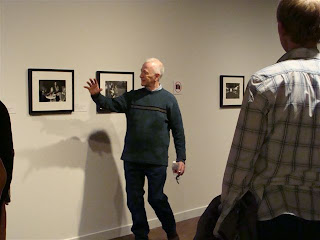
Another successful AMPed Up session took place today at The Glenbow Museum. George Webber, local renowned photographer, thoughtfully and openly shared many stories relating to his 'Hutterite Traditions' series of photographs on display at The Glenbow until April 13, 2009. These photographs stretch beyond mere documentation of a private colony unfolding as stories of relationships -- to places, peoples and traditions. The personal relationships Webber has established with many of the Hutterites from the Little Bow Colony are that of poignancy.
It is in these relationships between photographer and subject that trust develops and good photographs result. "A good photo is hinged on trust," Webber notes during his presentation. "Sometimes it's given before we've earned it, and other times it takes time to build."

As an extension of this trust, he sees great value in the working relationship between art directors, editors, photographers and the like. To have open dialogue and parameters set ahead of time avoids unnecessary tension and work. When possible, having an art director on location for a photo shoot can be very useful for both parties involved. He also stresses the importance of knowing where your images come from -- know who the source is.

Session attendees had the chance to share with George and the group some of their experiences and magazine samples for feedback. Great discussion ensued including image manipulation concerns, model release ethics, appropriation questions, publication rights, stock photo usage and cover layout/design. Following are brief notes on some of these issues:
Image manipulation: for assignment based work, photographer assumes there will be some manipulation to accommodate logistics. For example, if shooting a cover, it is necessary to be mindful of text and other information intended for the image. Some compromise is needed; sometimes things are removed or added. It is important to be truthful about the intent of such work, and to make it known to readers to maintain journalistic integrity.
Model release: can be broken down into two main categories -- one is made up of editorial/artistic/documentary and the other commercial. If an image is used for editorial, artistic or documentary, it is not necessary to employ model release forms (although, it's always best to check the latest on FOIP and with the publication in question). If model releases were needed for all of these purposes, the whole media world would essentially collapse; no newspapers, documentary films, magazines, photos or any other type of cultural creations would be possible. Still, if possible, it never hurts to ask for permission, just to be safe.
For the purposes of commercial, written release should be sought.
Publication rights: one-time production rights or first print rights are the most commonly used for photos in magazine publishing. George sees this as good practice. It allows magazines to showcase the work, but still allows photographers the opportunity to sell to various clients to increase exposure to a body of work.
See more of George's works at: georgewebber.ca.
-Stef Wong